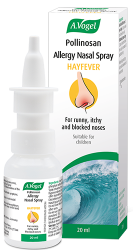We spend at least a third of our life in bed. This makes the bedroom the place we spend the most time in – ever! Wouldn't it be nice if each allergy sufferer had a bedroom that was not hazardous? Ideally, a bedroom's primary function should determine its design. That is, we should recognise that it is our sleeping room and make that its raison d'etre. A bed in an empty room, maybe a small table nearby to place your water and your book.
Unfortunately the reality, for many of us, is a bit more cluttered. My bedroom often doubles up as the house's storage dump. At the moment I have two bin bags of charity shop donations at the end of my bed. The top of my wardrobe is where we all keep old photos and treasures/dust traps – cough! Under my bed is full of boxes of winter clothes and spare blankets.
| An allergic reaction is caused by your own immune system. It's a reaction to something it sees as a threat. This threat should be harmful, like a hostile bacteria or virus. Sometimes, the immune system gets it wrong. It can identify something like a normal protein as something to be worried about. A peanut or a pollen grain may then end up triggering an immune response that is inappropriate. A dusty scarf can have you itching or sneezing in seconds, with your eyes streaming. While a cold usually goes away in about 7-10 days, an allergy can torment you for weeks on end. |
Allergies are associated with increased stress levels, anxiety and low mood1. It's very hard to sleep when you are itchy or when you can't breathe properly. Inadequate sleep can alter the mood and the ability to perform well. It may well start with the symptoms of an allergy but with a lasting, knock-on effect. The lack of sleep will negatively affect the immune system. Allergies can worsen and inflammation can take longer to calm down. It can take time to address a vicious circle of cause and effect. Examining your environment, the room you spend the most time in, is a good start.
Dust
Apparently, up to 12 million people in the UK have a dust allergy2. More fun facts about a dust allergy. Dust particles are made of lots and lots of dead human skin cells. This sounds gross but this is not the problem. The allergen is not to the dust itself but the protein in the faeces (poo) of dust mites. Dust mites are the microscopic fellas that like to eat our dead skin cells. They can produce up to 20 batches of droppings in a 24 hour period.
Dust mites (and their droppings) are everywhere and a bedroom is a great environment for them. Soft furnishings like mattresses and pillows. Lots of drawers, surface areas, teddies; way too much stuff.
Household chemicals
We use detergents in our washing machine. We like to have beautifully scented candles and air fresheners. Carpet cleaners, furniture polish and bathroom cleaners. Nail varnish and deodorants! My kids went through a phase with one particular deodorant: they used to spray it on the sly, hoping I wouldn't notice. They always got caught: my mouth would dry out, even if they were all the way upstairs. I'd be up like a shot, my lips stuck to my teeth and my nose streaming. Everyday household products and toiletries can be quite nasty. They can be full of ingredients that can irritate the airways and skin. Formaldehyde, ammonia, sodium hypochlorite and VOCs are all known irritants. These are the type of chemicals found in many cleaners, varnishes and air fresheners. They can be allergens or cause further aggravation to itchy skin or allergic rhinitis.
My Self-Care Tip: Reducing the chemicals in your home may help your allergies
Your allergies can be affected by many chemicals that are used daily in the home. In this video I give you some nice suggestions on toiletries that are free from chemicals and that are eco-friendly.
Fresh air
There's something very romantic about sleeping with the window open. A summer's breeze cooling touch. As it's waving the curtain gracefully over you it may also be dispersing pollen in its gentle puffs. If you live near a busy road or in an urban area, the air could be dense with environmental pollutants. Pollution can cause breathing difficulties and nasal inflammation. In hot weather the ground can get quite hot: the air rises. As the air and ground cool, the air falls again. Pollen can be swept along on this air movement and in at your window.
What can be done?
The bed
Mattresses and pillows can be covered in allergy proof covers. Teddies and bedding can be washed at temperatures over 60 degrees to kill dust mites. If you can't wash something at a high temperature, you can bung it in the freezer for 16 hours. The mites don't like that at all. Then the item can be washed gently. Use detergents that are suitable for sensitive skin. Avoid the heavily scented fabric conditioners. Air the bed everyday – we sweat a lot in our sleep. You don't want a damp bed that will attract mould.
Clutter
Try to eliminate clutter. More stuff equals more surface area. A dressing table filled with make-up and jewellery. A bookshelf or open shelving. Heavy cloth curtains. The bedroom can be a giant bowl of dust, pollen and mould. If you have to store things in your room, try to keep them in a drawer, box or wardrobe. It should be easy to clean the room thoroughly and quickly. The bedroom needs to be cleaned very frequently. Dust with a damp cloth and wear a mask while you do it. Make sure the vacuum cleaner has a HEPA filter. I hate those smelly old machines that just spew more dust around.
Pets
Even if you are not allergic to your cat, their fur can be harbouring all sorts of delights. Pollen, dust and mould. If you are allergic to animals it's their saliva and other secretions that will bother you. It's sensible to keep the mutts in their own sleeping spaces and not share yours. Make sure that they are kept as clean as possible.
Air
It may be better to invest in an air purifier if the open window is a problem. Make sure that it has a HEPA filter. If the air is damp, use a dehumidifier. If the air is too dry you can use a vaporiser. Essential oils are scented natural plant extracts that are great in the bedroom. Eucalyptus and peppermint oils can help open the airways and ease congestion. Lavender oil can help to give a relaxed and peaceful atmosphere.
Remember that none of these changes needs to cost the earth. A clean, uncluttered room will save you time and energy. It will be more restful. You'll feel much better.
Do remember that it is important to treat the symptoms of your allergy. It's as important as trying to reduce your exposure to the allergen. Try to start treatment at the first sign of trouble. Early intervention can reduce the severity of symptoms.
A.Vogel Pollinosan is a licenced remedy for the relief of hayfever and allergic rhinitis. It is non-drowsy and can be used long-term. There is a Pollinosan Nasal Spray too, which I love. It clears the nose of dust and pollen. This helps with any sneezing or congestion. The spray can be used alongside the tablets.
My Top Tip:

Try Pollinosan Hayfever Tablets to combat symptoms of hayfever and allergic rhinitis.
✔ Non-drowsy
✔ Can be used with other hayfever remedies
✔ Suitable for children over 12
"My hayfever cleared quite quickly whilst taking these tablets."
References:
1. https://journals.plos.org/plosone/article?id=10.1371/journal.pone.0072507
2. https://www.independent.co.uk/life-style/health-and-families/health-news/millions-suffer-home-fever-as-allergy-epidemic-begins-to-bite-6261925.html





 Looking for a solution to curb those hayfever symptoms such as itchy eyes, constant sneezing and congestion, then look no further than A.Vogel’s Pollinosan Hayfever tablets.
Looking for a solution to curb those hayfever symptoms such as itchy eyes, constant sneezing and congestion, then look no further than A.Vogel’s Pollinosan Hayfever tablets.

